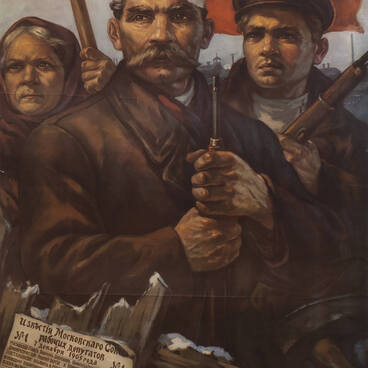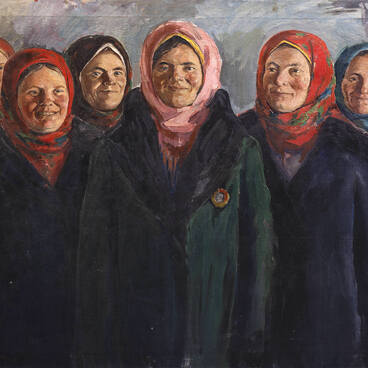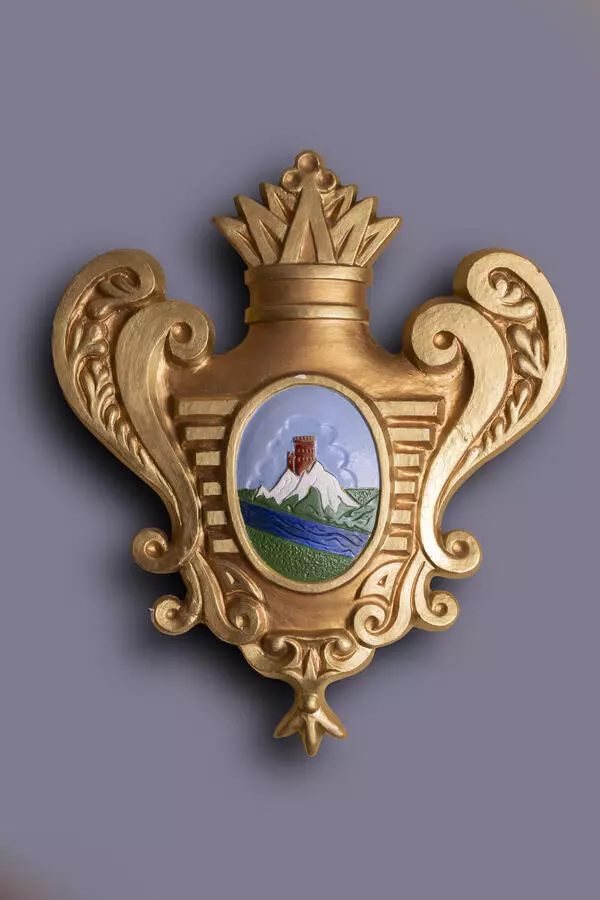The exhibit was made for the permanent exhibition of the hall “Oskol Fortress” in 1996.
The coat of arms of Stary Oskol was established in 1780. It displays a shield divided into three parts. The upper part features the coat of arms of the city of Kursk — a blue stripe on a silver field, with three flying partridges on it. Below the shield is divided diagonally into two parts: one part in the red field shows a rifle, the other (in the green field) — a gold sokha (wooden plow). The description of the coat of arms gives the following comment, “The coat of arms is designed so because the inhabitants of these villages are the old soldiers, practicing ploughing in their free time, which is why the coat of arms combines a military tool with a diligent ploughman’s tool.”
On August 5, 1800, Emperor Paul I, continuing the work of Catherine II, ordered the Heraldry Commission to begin compiling a “General Armorial of the Cities” under the title “General Armorial of the Russian Empire”. The originals of the approved coats of arms were to be kept in commissions, and the cities were to be given their copies. Work on drawing up rules of the Russian city heraldry continued intensively. The rules of decorating coats of arms of provinces, regions, cities, and towns were compiled by Baron Koehne in 1857 and approved in May-June of the same year by Emperor Alexander II.
In Russia city emblems appeared several centuries later than in Western Europe. They emerged as a result of the development of territorial emblems, originating from ancient totemic cults, property signs of certain clans and people. A city’s coat of arms also reflected the specific features of the city that were unique to it.
The coat of arms consisted of the inner and outer parts. The inner part represented a shield with the image of symbolic figures in it, and the outer one featured crowns and ornaments. In the coats of arms of provincial and capital cities, the heraldic image on the shield was crowned with the imperial crown. In a city’s emblem, the provincial coat of arms was to occupy the free part of the shield — a rectangle of a little less than a quarter of it — in the right or left corner. In the coat of arms of a district town the free part was absent, and the coat of arms of the province took up one-third of the top part of the shield. Thus, the full coat of arms of the city of Stary Oskol represented a shield of a French shape, that is, a rectangle, the base of which is equal to 8/9 of the height, protruding in the middle of the lower part of the edge and had rounded lower corners.
The coat of arms of Stary Oskol was established in 1780. It displays a shield divided into three parts. The upper part features the coat of arms of the city of Kursk — a blue stripe on a silver field, with three flying partridges on it. Below the shield is divided diagonally into two parts: one part in the red field shows a rifle, the other (in the green field) — a gold sokha (wooden plow). The description of the coat of arms gives the following comment, “The coat of arms is designed so because the inhabitants of these villages are the old soldiers, practicing ploughing in their free time, which is why the coat of arms combines a military tool with a diligent ploughman’s tool.”
On August 5, 1800, Emperor Paul I, continuing the work of Catherine II, ordered the Heraldry Commission to begin compiling a “General Armorial of the Cities” under the title “General Armorial of the Russian Empire”. The originals of the approved coats of arms were to be kept in commissions, and the cities were to be given their copies. Work on drawing up rules of the Russian city heraldry continued intensively. The rules of decorating coats of arms of provinces, regions, cities, and towns were compiled by Baron Koehne in 1857 and approved in May-June of the same year by Emperor Alexander II.
In Russia city emblems appeared several centuries later than in Western Europe. They emerged as a result of the development of territorial emblems, originating from ancient totemic cults, property signs of certain clans and people. A city’s coat of arms also reflected the specific features of the city that were unique to it.
The coat of arms consisted of the inner and outer parts. The inner part represented a shield with the image of symbolic figures in it, and the outer one featured crowns and ornaments. In the coats of arms of provincial and capital cities, the heraldic image on the shield was crowned with the imperial crown. In a city’s emblem, the provincial coat of arms was to occupy the free part of the shield — a rectangle of a little less than a quarter of it — in the right or left corner. In the coat of arms of a district town the free part was absent, and the coat of arms of the province took up one-third of the top part of the shield. Thus, the full coat of arms of the city of Stary Oskol represented a shield of a French shape, that is, a rectangle, the base of which is equal to 8/9 of the height, protruding in the middle of the lower part of the edge and had rounded lower corners.




